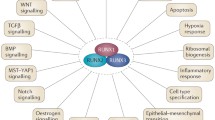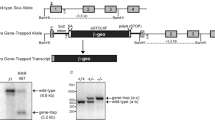Abstract
Apoptosis Protease-Activating Factor 1, APAF1, was originally isolated four years ago and shown to be the mammalian homologue of the C. elegans pro-apoptotic ced4 gene. Since then, the expression of APAF1 has been demonstrated to be involved in several cell death pathways, including the induction of apoptosis by the p53 tumour suppressor protein and neuronal apoptosis. In this review we will focus on the regulation of APAF1 expression, in particular with regard to recent developments in our understanding of the role of APAF1 in both tumourigenesis and mammalian development.
Similar content being viewed by others
References
Nunez G, Benedict MA, Hu Y, Inohara N Caspases: The proteases of the apoptotic pathway. Oncogene 1998; 17: 3237–3245.
Zou H, Henzel WJ, Liu X, Lutschg A, Wang X Apaf-1, a human protein homologous to C.elegans CED-4, participates in cytochrome-c dependent activation of caspase 3. Cell 1997; 90: 405–413.
Srinivasula SM, Ahmad M, Fernandes-Alnemri T, Alnemri ES Autoactivation of procaspase9 by APAF1-mediated oligomerisation. Mol Cell 1998; 1: 949–957.
Li P, Nijhawan D, Budihardjo I, et al Cytochrome c and dATPdependent formation of Apaf-1/caspase-9 complex initiates an apoptotic protease cascade. Cell 1997; 91: 479–489.
Benedict MA, Hu Y, Inohara N, Nunez G Expression and functional analysis of Apaf1 isoforms. J Biol Chem 2000; 275: 8461–8468.
Chau BN, Cheng EH, Kerr DA, Hardwick JM Aven, a novel inhibitor of caspase activation, binds Bcl-Xl and Apaf-1. Mol Cell 2000; 6: 31–40.
Xanthoudakis X, Nicholson DW Heat-shock proteins as death determinants. Nat Cell Biol 2000; 2: E163-E165.
Coldwell MJ, Mitchell S.A. M, Stoneley M, MacFarlane M, Willis AE Initiation of Apaf-1 translation by internal ribosome entry. Oncogene 2000; 19: 899–905.
Mitchell SA, Brown EC, Coldwell MJ, Jackson RJ, Willis AE Protein factor requirements of the Apaf-1 internal ribosome entry segment: roles of polypyrimidine tract binding protein and upstream of N-ras. Mol Cell Biol 2001; 21: 3364–3374.
Rodriguez J, Lazebnik Y Caspase-9 and APAF-1 form an active holoenzyme. Genes Dev 1999; 13: 3179–3184.
Perkins C, Kim CN, Fang G, Bhalla KN Overexpression of Apaf-1 promotes apoptosis of untreated and paclitaxel-or etoposide-treated HL-60 cells. Cancer Res 1998; 58: 4561–4566.
Soengas MS, Capodieci P, Polsky D, et al Inactivation of the apoptosis effector Apaf-1 in malignant melanoma. Nature 2001; 409: 207–211.
M¨ uller H, Bracken AP, Vernell R, Moroni MC, Christians F, Grassilli E, Prosperini E, Vigo E, Oliner JD, Helin K E2Fs regulate the expression of gene involved in differentiation development, proliferation, and apoptosis. Genes Dev 2001; 15: 267–285.
Moroni MC, Hickman ES, Caprara G, et al APAF-1 is a transcriptional target for E2F and p53. Nature Cell Biol 2001; 3: 552–558.
Ryan KM, Phillips AC, Vousden KH Regulation and function of the p53 tumor suppressor protein. Curr Opin Cell Biol 2001; 13: 332–337.
Soengas MS, Alarc´on RM, Yoshida H, et al Apaf-1 and Caspase-9 in p53-dependent apoptosis and tumor inhibition. Science 1999; 284: 156–159.
Zhou L, Song Z, Tittel J, Steller H HAC-1, a Drosophila homolog of APAF-1 and CED-4, functions in developmental and radiation-induced apoptosis. Mol Cell 1999; 4: 745–755.
Fortin A, Cregan SP, MacLaurin JG, et al APAF1 is a key transcriptional target for p53 in the regulation of neuronal cell death. J Cell Biol 2001; 155: 207–216.
Wolf BB, Schuler M, Li W, et al Defective cytochrome c-dependent caspase activation in ovatian cancer cell lines due to diminished or absent apoptotic protease activating factor-1 activity. J Biol Chem 2001; 276: 34244–34251.
Martin SJ Dealing the CARDs between life and death. Trends Cell Biol 2001; 11: 188–189.
Nagata S Apoptosis by death factor. Cell 1997; 88: 355–365.
Yuan J, Yanker BA Apoptosis in the nervous system. Nature 2000; 407: 802–809.
Cecconi F, Alvarez-Bolado G, Meyer BM, Roth KA, Gruss P Apaf1 (CED-4 homolog) regulates programmed cell death in mammalian development. Cell 1998; 94: 727–737.
Yoshida H, Kong Y-Y, Yoshida R, et al Apaf1 is required for mitochondrial pathways of apoptosis and brain development. Cell 1998; 94: 739–750.
Honarpour N, Gilbert SL, Lahn BT, Wang X, Herz J Apaf-1 deficiency and neural tube closure defects are found in fog mice. Proc Natl Accad Sci USA 2001; 98: 9683–9687.
Kanuka H, Sawamoto K, Inohara N, et al Control of the cell death pathway by Dapaf-1, a Drosophila Apaf-1/CED-4-related caspase activator. Mol Cell 1999; 4: 757–769.
Rodriguez A, Oliver H, Zou H, et al Dark is a Drosophila homologue of Apaf-1/CED-4 and functions in an evolutionarily conserved death pathway. Nat Cell Biol 1999; 1: 272–279.




